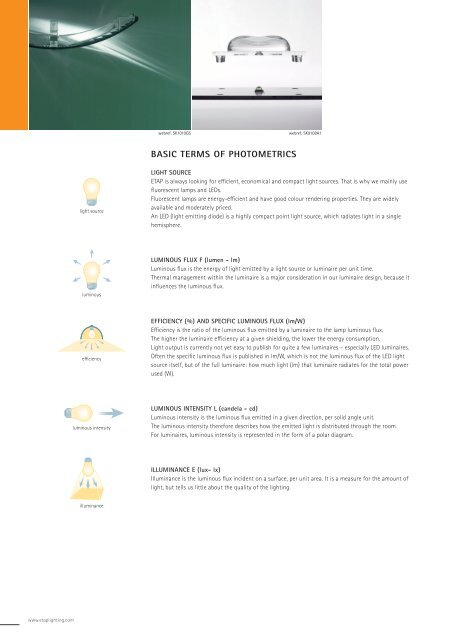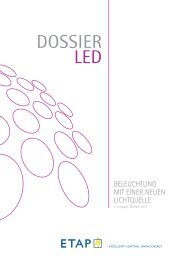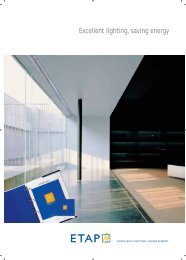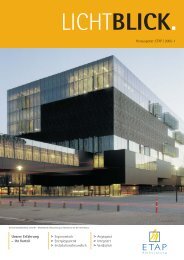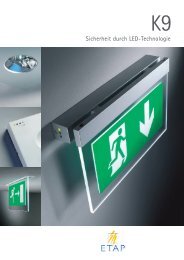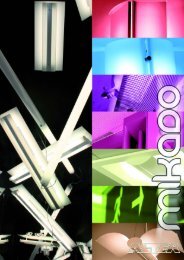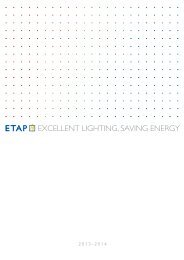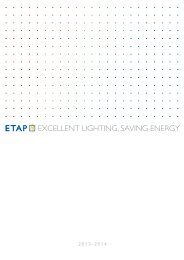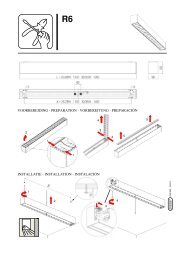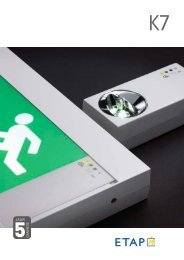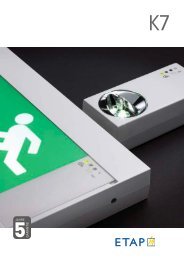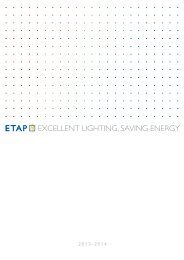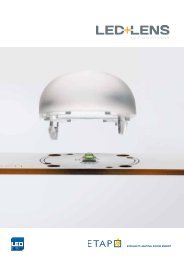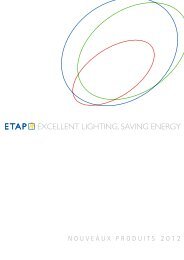Concepts - ETAP Lighting
Concepts - ETAP Lighting
Concepts - ETAP Lighting
Create successful ePaper yourself
Turn your PDF publications into a flip-book with our unique Google optimized e-Paper software.
www.etaplighting.com<br />
light source<br />
luminous<br />
efficiency<br />
luminous intensity<br />
illuminance<br />
webref. SK1010G5 webref. SK9108A1<br />
BASIC TERMS OF PHOTOMETRICS<br />
LIGHT SOURCE<br />
<strong>ETAP</strong> is always looking for efficient, economical and compact light sources. That is why we mainly use<br />
fluorescent lamps and LEDs.<br />
Fluorescent lamps are energy-efficient and have good colour rendering properties. They are widely<br />
available and moderately priced.<br />
An LED (light emitting diode) is a highly compact point light source, which radiates light in a single<br />
hemisphere.<br />
LUMINOUS FLUX F (lumen - lm)<br />
Luminous flux is the energy of light emitted by a light source or luminaire per unit time.<br />
Thermal management within the luminaire is a major consideration in our luminaire design, because it<br />
influences the luminous flux.<br />
EFFICIENCY (%) AND SPECIFIC LUMINOUS FLUX (lm/W)<br />
Efficiency is the ratio of the luminous flux emitted by a luminaire to the lamp luminous flux.<br />
The higher the luminaire efficiency at a given shielding, the lower the energy consumption.<br />
Light output is currently not yet easy to publish for quite a few luminaires – especially LED luminaires.<br />
Often the specific luminous flux is published in lm/W, which is not the luminous flux of the LED light<br />
source itself, but of the full luminaire: how much light (lm) that luminaire radiates for the total power<br />
used (W).<br />
LUMINOUS INTENSITY L (candela - cd)<br />
Luminous intensity is the luminous flux emitted in a given direction, per solid angle unit.<br />
The luminous intensity therefore describes how the emitted light is distributed through the room.<br />
For luminaires, luminous intensity is represented in the form of a polar diagram.<br />
ILLUMINANCE E (lux- lx)<br />
Illuminance is the luminous flux incident on a surface, per unit area. It is a measure for the amount of<br />
light, but tells us little about the quality of the lighting.
luminance<br />
shielding reflectors<br />
shielding lenses<br />
LUMINANCE L (cd/m²)<br />
Luminance is a measure for the clarity of the source in a specific direction and is closely related to the<br />
subjective brightness perception.<br />
Control of the luminances of luminaires is essential for comfortable lighting.<br />
Standard EN12464-1 imposes restrictions on average luminances, but <strong>ETAP</strong> also invariably pays attention<br />
to limiting peak luminances.<br />
SHIELDING<br />
REFLECTORS<br />
<strong>ETAP</strong> reflectors ensure that, for certain viewing directions, no direct light from the lamp can fall<br />
into the eyes. This is referred to as physical shielding. However, it is equally important that no<br />
mirror images of the lamp are visible in the reflector. This is known as optical shielding.<br />
In <strong>ETAP</strong> products, the optical shielding is at least equal to the physical shielding. For reflector<br />
shielding, the following terms are used:<br />
• cut-off angle g<br />
• shielding angle (complement of g)<br />
LENSES<br />
Optical shielding can also be achieved with lenses. A sophisticated lens definition ensures that<br />
bright luminance of the light source cannot be seen in normal direction of view, thus satisfying<br />
the requirements for luminance perception and UGR.<br />
webref. SA049O5<br />
<strong>ETAP</strong><br />
GENERAL
LED+LENS TM<br />
MICROLUM®<br />
ISOLUM®<br />
EQUILUM®<br />
MesoOptics TM<br />
SOFTLIGHT<br />
HaloOptics®<br />
OPTICS<br />
LENSES<br />
LED+LENS TM<br />
LED+LENS TM is a combination of efficient high-power LEDs and sophisticated lenses, used to<br />
optimise light distribution.<br />
LED+LENS TM provides high specific luminous flux and high visual comfort.<br />
REFLECTORS<br />
HRSilver TM - ALUMINIUM<br />
<strong>ETAP</strong> uses HRSilver TM aluminium for the large majority of its reflectors.<br />
This aluminium has an extremely high reflection factor (98%). As a result, HRSilver TM reflector<br />
luminaires have a considerably higher efficiency, allowing you to save more energy.<br />
SYMMETRICAL LOW LUMINANCE (SLL) BAFFLES<br />
Parabolically shaped with a flat top cover. They provide good luminance control longitudinally<br />
and transversely.<br />
MICROLUM® BAFFLES<br />
Parabolically shaped, with stepped top cover employing the Fresnel technique.<br />
MICROLUM® baffles have low average luminances in all directions and significantly reduce peak<br />
luminances.<br />
ISOLUM® BAFFLES<br />
Parabolically shaped, with continuously formed top cover. They result in low average luminances<br />
in all directions and eliminate peak luminances.<br />
EQUILUM® BAFFLES<br />
Parabolically shaped on top and bottom sides. They prevent peak luminances and ensure perfectly<br />
uniform shielding in all directions.<br />
DIFFUSERS<br />
MesoOptics TM<br />
MesoOptics diffusers contain a precise microstructure that distributes the light in a controlled<br />
fashion. The efficiency is about 30 % higher than that of luminaires using conventional diffuser<br />
techniques. The result is rigidly and evenly illuminated optics without lamp silhouette and without<br />
any disturbing luminances or colour interference.<br />
SOFTLIGHT<br />
Softlight luminaires clearly show where the light comes from. They use the entire surface of the<br />
luminaire to evenly spread the light. They increase the brightness impression of the entire room.<br />
HaloOptics®<br />
HaloOptics® is a diffuser with a high transmission factor. Conventional diffusers create their<br />
diffusing effect by including impurities in the material, whereby much of the light is lost.<br />
HaloOptics® uses transparent inclusions, so that less light is lost and luminaire efficiency<br />
remains higher.<br />
webref. SUTX003C<br />
<strong>ETAP</strong><br />
LIGHTING


